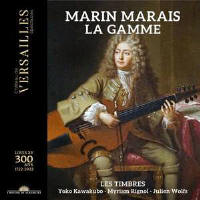Texte paru dans: / Appeared in:
Château de Versailles |
|
|
Outil de traduction |
|
|
When Marais published La gamme et autres morceaux de symphonie in 1723, he was 67 years old. He would die five years later. In scope, the collection is unique in Marais’s output, and can be interpreted as a summation of sorts. The first work, La gamme, is – no extra marks here – a kind of scale: it begins in C major and moves up step by diatonic step to arrive an octave higher. A mirrored descent brings us back to C major. Marais seems to have delighted in imposing such strictures on his craft; they forced him to conjure musical contrasts and emotions through other means. And so here we have a variety of changing dance forms, each bringing a slightly different character through metre, tempo and rhythmic patterns.
At nearly 900 bars in length, tedium will always be an issue with any recording of La gamme. These performances from Les Timbres are undeniably joyful. ‘Fa’ (track 4), on the way up that is, moves from open, breezy lyricism to unexpected virtuosity. Gambist Myriam Rignol is exceptional in charting this trajectory, and the independent articulations of Julien Wolfs’s two hands on harpsichord is a marvel. The descending ‘La’ (track 10), particularly in the major section as Rignol turns to pizzicato, is as cute as freshly bought babywear. Yet even in these two lovely movements, there are signs of an intensity that can be slightly oppressive. The dynamic between the members of Les Timbres is over-keen, sometimes even grabby. I yearn for light and shade, the wise and elegant repose that seems so naturally sketched by Trio Sonnerie: the space that they give the various backsand-forths to speak is vital in such an overwhelming structure.
But such intensity is cleverly channelled by Les Timbres in the closing Sonnerie de Sainte Geneviève du Mont de Paris, a chaconne on only three notes (D-F-E). Supposedly this is to represent the three bells of the abbey (which adjoined the church of Saint-Étienne-du-Mont still visible in Paris today). Yet still I’m stirred by a possible story that the church bells evoked childhood memories for Marais. Again, then, I wonder whether this rather tunnel-vision chaconne – gloriously severe at times – might benefit from passages more deeply dipped in Proustian nostalgia.
|
|




